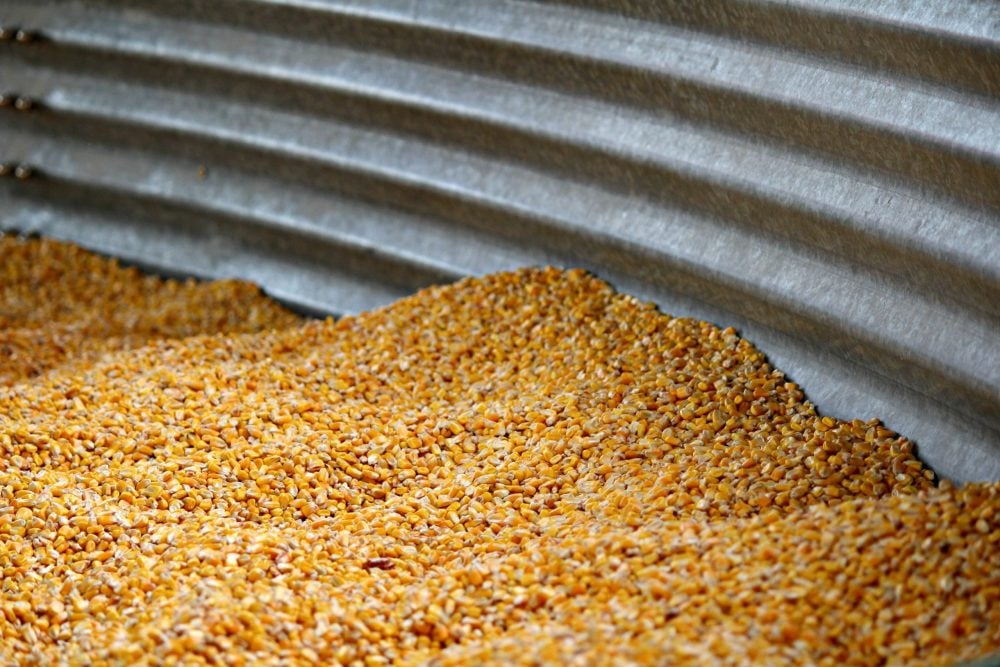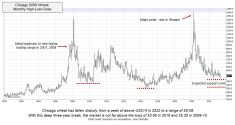From July 15 through Aug. 15, most of the Ontario growing region experienced average temperatures and normal precipitation. Eastern counties such as Durham, Northumberland, Peterborough and Hastings have been on the drier side but crops have held up fairly well. We continue to project above average yields for Ontario corn and soybean crops.
The Ontario winter wheat harvest has wrapped up and yields exceeded expectations. Corn, soybean and wheat markets are in the process of making seasonal lows. Elevator companies have lowered their basis levels in anticipation of larger producer deliveries. At the same time, August and September are two months when markets suffer from a lack of demand. Favourable crop conditions have caused buyers and end users to wait until harvest before increasing coverage for the 2022-23 crop year.
Quick look
Soybeans: Ontario production will be above the five-year average; U.S. yields are projected to be higher than estimated.
Corn: U.S. corn estimates have been lowered due to hot, dry conditions during pollination.
Wheat: Despite concerns over the Russian war on Ukraine, there will not be a shortage of global wheat supplies.
Read Also

Cycle swings dictate farming profitability
It can be profitable to understand where the crop markets are positioned in the context of their big-picture cycles.
U.S. corn and soybean yields are still being disputed. On the August World Agriculture Supply and Demand Estimates (WASDE), the USDA lowered the corn yield but increased the soybean yield. The grain trade continues to project trend type yields for corn and soybeans as the crops usually yield better than expected in the absence of extreme weather.
The corn market is digesting lower European corn production estimates but this will not have a large influence on the global price structure. The European drought has no significant impact on the soybean market. Europe imports about 14.5 million tonnes of soybeans every year as production is minimal. More importantly, the economic slowdown in China has resulted in lower-than-expected corn and soybean imports.
In the short term, the financial markets have a “risk-off” sentiment that has resulted in a broad sell-off of all major currencies against the greenback. Chinese data on factory output, investment, consumer spending and real estate were negative for July. Energy prices remain elevated and the ongoing Russian war with Ukraine has tempered global economic growth prospects.
Canadian and U.S. inflation data was lower in July but the central banks will continue to increase interest rates until the end of 2022.
The U.S. release of crude oil reserves comes to an end in October, which could cause energy prices to reach record highs. This will cause a surge of speculative money flow into corn, soybean and wheat markets. Exports of corn and wheat have resumed from the Ukraine but the volume isn’t significant enough to influence world prices. The grain and oilseed markets remain sensitive to war developments, especially around the Zaporizhzhia nuclear plant. China continues to practice military drills around Taiwan, while another U.S. delegation visits the island. At the same time, China is contending with drought- like conditions in the southern regions.
Soybeans
We continue to project an Ontario soybean crop of 4.2 million tonnes, up from 4.1 million tonnes last year and up from the five-year average of 3.9 million tonnes. Ontario soybeans for November delivery have been hovering around $18/bu. Basis levels have deteriorated as harvest approaches.
The soybean pod filling stage in Canada and the U.S. occurred without adverse weather. Ontario crushers tend to take their downtime for upgrades and maintenance during late summer. The bulk of Ontario soybean exports trade to Europe, Algeria and Egypt. Buyers in these countries are on holidays during August.
Domestic and export demand for Ontario soybeans is at a standstill in August. Exports and the domestic crush will only increase in October and move into high gear in November. It’s important that producers realize this seasonality in demand.
When traders and analysts are taught how to analyze markets and trade flows, start with global projections for the crop year. We first look at global oilseed production for the 2022-23 campaign, which is expected reach 646 million tonnes. This is up from the 2022 global oilseed output of 600 million tonnes and up from the five-year average of 592.8 million tonnes. There are sizeable increases in Canadian canola production and the upcoming South American soybean crop.
U.S. soybean production is expected to come in at 123 million tonnes, up from the 2021 output of 120.7 million tonnes. Brazil and Argentina are on an October through September crop year. The crop harvested this past spring in Brazil was estimated at 126 million tonnes, down 13.5 million tonnes from last year. For the 2022-23 crop year, Brazilian production is expected to reach 149 million tonnes. Next spring, Argentina is expected to harvest 51 million tonnes, up seven million. But remember, the Brazilian and Argentinean crops are planted from October through December.
What to do: We’ve advised Ontario producers to be 20 per cent sold on their 2022 production for harvest delivery. We’re planning our next sales recommendation in November. At that time, the market will have absorbed North American harvest pressure and we’ll have weather and acreage forecasts for South America. At the same time, we’re expecting a surge in speculative money flow as crude oil prices are projected to reach historical highs over the winter.
Corn
The Ontario corn crop experienced favourable conditions during the key pollination and silking phase. We’re now expecting the Ontario corn crop to reach 10 million tonnes, up from the 2021 production of 9.5 million tonnes and up from the five-year average of 8.9 million tonnes.
Producer selling will surge over the harvest period, causing the basis to deteriorate. Cattle on feed inventories are at seasonal lows during September and exports only start to increase in November. Therefore, we avoid making sales recommendations during the harvest period.
Grain companies are estimating European corn production in the range of 52 to 55 million tonnes. Last year’s output was 71 million tonnes. At the time of writing this article, French corn was offered at US$334/tonne while selling indications for Ontario corn were US$285/tonne f.o.b. St. Lawrence for October. There is a natural trade flow for Ontario corn to move into Northern European destinations.
To reiterate from our previous issue, companies sourcing for export markets will reflect stronger prices than domestic end users during the fall period. Later in winter, the reverse will occur as domestic demand increases. The exportable surplus from Brazil dries up in November. U.S. corn out of the Gulf is US$40/discount to Brazilian offers for November shipment.
The U.S. corn crop has experienced minor yield drag due to warmer temperatures and drier conditions during pollination. U.S. corn output is expected to finish near 365 million tonnes, down from the 2021 crop of 383 million tonnes. The five-year average output is also 365 million tonnes.
In China, economic woes continue to weigh on corn demand. Chinese corn imports during July were 1.54 million tonnes, down 46 per cent from July 2021. Total year-to-date imports are 15.13 million tonnes, down 17 per cent from last year. Chinese corn imports will likely improve in October once the economy turns the corner.
The managed money has been a major buyer of corn futures over the past month. Their net long was 103,315 on July 19 but this increased to 142,646 contracts on Aug. 16. The market will likely trade sideways through the harvest period so the speculative money will be on both sides of the market.
Later in November, we’re looking for the managed money to build the long position up to 240,000 contracts. This buying will result in an upward trending market in the latter part of fall and early winter.
What to do: We’ve advised producers to be 20 per cent sold on their 2022 production. This will allow movement off the combine. We’re planning to make our next sales recommendation in November. At that time, the North American harvest will be wrapped up and U.S. exports will be in high gear. Speculative buying will also enhance the price structure. Basis levels will improve in Ontario due to strengthening domestic demand while exports experience a sharp year-over-year increase. Stronger energy prices over the winter will increase ethanol demand for corn.
Wheat
Ontario wheat prices have been trending lower through the summer. The soft red winter wheat harvest occurred without adverse weather and more than 90 per cent of the crop is milling quality. Basis levels have eroded during the summer and domestic millers appear to be well covered for their nearby requirements.
Canadian soft red winter wheat f.o.b. the St. Lawrence appears to be priced at a discount compared to U.S. soft red winter out of the Gulf and French soft wheat f.o.b. Rouen. However, given current ocean freight spreads to major markets, all there three exporters are competitively priced.
The Northern Hemisphere winter wheat harvests are completed. The spring wheat harvests in Russia, the U.S. and Canada will be finished by the end of September. For the most part, harvest pressure is over. We’re starting to see more tenders from Africa and Southeast Asia. This market environment causes a seasonal rally from mid-September through mid-November.
The drought in China has little effect on corn and soybeans but it’s a major issue for the winter wheat growing area. If this drought is prolonged into the fall, it will influence winter wheat planting and early development.
September will be the seventh month for the Russian invasion of Ukraine. At the time of writing this article, the December Chicago wheat contract was trading around $7.85 and the close on Jan. 31, 2022 was $7.65. The war premium has evaporated from the wheat market. The world is not reliant on Ukraine and Russian supplies at this time with plentiful stocks in Europe, the U.S. and Canada. Later in winter, it will be different story.
In past years, Russian wheat has traded into Central and South America, which are typical homes for Canadian and U.S. origin. This year, Russia won’t be a major player in these traditional North American markets, which will enhance export demand for Ontario soft red winter.
There is no shortage of wheat in the world. According to the USDA, world wheat production will reach 770 million tonnes for the 2022-23 crop year, unchanged from last year and up from the five-year average of 762 million tonnes. If we look at major exporters (Argentina, Australia, Canada, Europe, Russia and Ukraine) production is expected to come in at 326 million tonnes, unchanged from last year and up from the five-year average of 322 million tonnes. Producers need to look at seasonal rallies due to demand and monitor global events, which are unpredictable.
What to do: We’ve advised Ontario farmers to be 10 per cent sold on their winter wheat. We’re planning to make our next sales recommendations in late October or early November.















